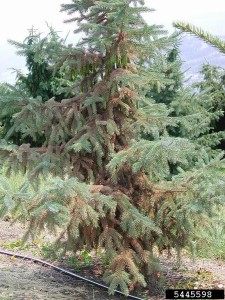Spider mites become active in mid-May and begin feeding on the needles of spruce. These mites are easily moved to other trees by wind or by hitching a ride on the bodies of birds or other animals. Infestations are more likely during dry conditions. There are many generations of mites born each year.

Key Points
- Damage on White or Colorado Spruce Trees results in blotchy needles and eventual needle loss. Fine webbing amongst needles indicates a high infestation.
- Mites prefer dry conditions, so regular spray from a hose nozzle increases tree humidity and dislodges mites.
Tree Damage
Mites feed by puncturing needles and sucking out cell contents. This feeding results in blotchy needles, and eventual needle loss, starting on the inner needles of lower branches and progressing to newer needles.
A close look may reveal very fine webbing amongst the needles. This webbing should not be confused with spider webs which are much bigger. Another test is to hold a sheet of white paper beneath a branch and then tapping the branch to dislodge the mites. The tiny black mites are then easily seen as they move across the paper.
Control Measures
- Keep trees well watered and canopies moist to prevent infestation
- These mites prefer dry conditions so regular moistening of the interior canopy will increase the humidity in the tree and dislodge any mites present.
- Heavy Infestations can be treated with a contact pesticide in the Spring. We recommend using a certified pesticide applicator to complete this service.

